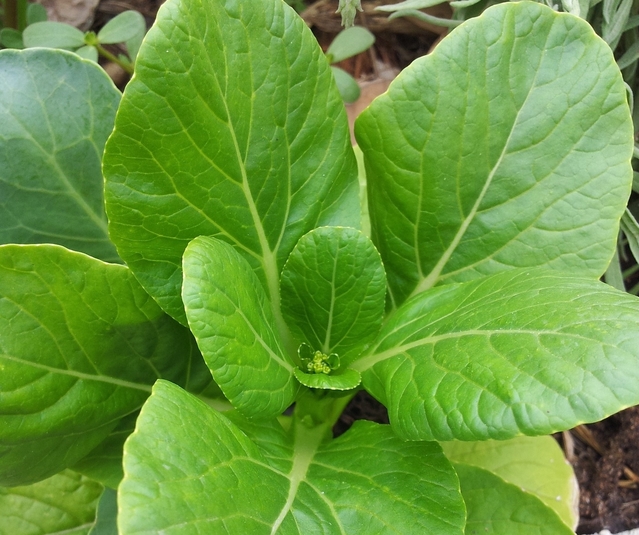Mustard greens are fast growing, nutritious leafy greens. They're perfect for gardens and containers in both spring and fall. They are a high biomass, nitrogen lifter for growing over the summer. It is one of the quickest growing, green manuring species and is very good at suppressing weeds. Used for creating short term green cover and game cover.
Mustard Greens
aka Mizuna, Mustard Spinach, Indian Mustard
Annual plant
Height: 6" Width: Up to 2'
Mustard Greens are a leafy plant with a zesty mustard flavor that is a fiber and nutrient-rich addition to salads and stir-fries.
Types:
Curly Leaf. Curled or frilled leaf edges resembling Kale. It's a very spicy tender green used in salads.
Flat Leaf. Broad delicately flavored leaves are good for steaming or in soups.
Mustard Spinach. Smooth leaves. This plant is more tolerant of heat, making it a good choice in warmer climates.
Starting Seeds of Mustard Greens
Seed Depth: Lightly cover the seed and tamp down on the soil.
Seed Spacing: 6" apart, and thin to 19" apart.
Germination Temp: 45-85 degrees.
Days to Germinate: 4-7 days.
Days to Harvest: 30-40 days or 60-70 days depending on the variety.
Seed Longevity: 2-3 years.
Sowing Indoors:
Spring: Sow 6 weeks before your average last frost date. Plant out 3 weeks before your average last frost date.
Sowing Outdoors:
Spring: Direct sow 3-4 weeks before your average last frost date.
Winter Sowing:
If you haven't tried winter sowing, you're in for a treat. This method is especially good for sowing herbs and greens. Winter sowing is basically sowing seeds in the bottom of a milk jug during the winter, setting the milk jugs outside for the winter and leaving them there until the seeds germinate in Spring.
For more detailed information about Winter Sowing, click here.
To watch our 30 minute video on how to winter sow, click here.
Growing Mustard Green Plants
Growing Temperature: Tolerates light frosts which make leaves sweeter.
Plant Spacing: 12"
Container Size: 8" deep.
Sun/Shade: Sun is ideal. It also tolerates shade.
Soil: Moist, rich, well-draining.
Watering: Evenly moist for best flavor. 2" water per week.
Try Audible and Get Two Free Audiobooks
Fertilizing
Since greens are such a fast-growing crop, as long as they are grown in rich soil there may be little need for further fertilization. That said, a liquid balanced fertilizer when the seedlings are 4" tall will give your greens a boost and carry them through their short season. After the temperatures warm, though, the leaves of Arugula will turn bitter and no amount of fertilizer will help at that point.
Growing Tips
Sow Mustard Greens in succession every 2-3 weeks for a steady supply.
Harvesting Mustard Greens
Begin harvesting outer leaves in about 4 weeks when the leaves are 6-8" long, or treat as cut-and-come-again and harvest the whole plant 3" above ground level.
Using Mustard Greens
- Use smaller Mustard Green leaves in salads or on sandwiches for a peppery zing.
- Use steamed, braised, cooked in broth.
Storing Mustard Greens For Later Use
Although tender green leaves, like lettuce, cannot be preserved well, the thicker leaved greens can be preserved.
Fresh
- Clean and pat dry. Bundle stems lightly, place on a paper towel (to absorb moisture) and wrap in a plastic bag. Keeps in refrigerator for 10 days.
Freezing for Later Use in Chilis, Soups, Sauces, and Casseroles.
- Steam or saute' leaves, chop them and store in freezer bags.
- Puree with water and freeze into ice cube trays.
- Clean and dry the leaves and store in quart size freezer bags.
- Frozen leaves will keep for 6 months.
- Blanching the leaves first for two minutes will extend freezer storage to 14 months.
~~~~~~~~~~~~~~~~~~~~~~~~~~~~~~~~~~~~~~~~~~~~~~~~~~~~~~
Mustard greens are fast growing, nutritious leafy greens. They're perfect for gardens and containers in both spring and fall. Although not quite as cold hardy as collards or kale but mustard greens do tolerate a light frost, which makes their leaves sweeter.
In areas where there are no killing freezes, gardeners enjoy growing mustard greens all winter long. The mustard patch is a pretty sight in the cool season garden. The leafy plants are easy to care for and good companions to fall flowers such as pansies. Mustard greens grow in a rosette of leaves up to about a foot-and-a-half tall. You can simmer the big peppery greens or pick smaller, young leaves to eat raw in salads and sandwiches.
~~~~~~~~~~~~~~~~~~~~~~~~~~~~~~~~~~~~~~~~~~~~~~~~~~~~~~~~~~~~~~~~~~~~~~
This post may contain Amazon affiliate links and as an Amazon Associate I earn from qualifying purchases without costing you anything extra.



.webp)















